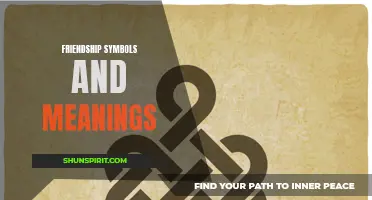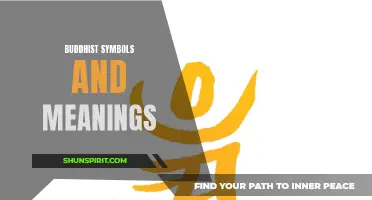
Bohemian symbols have long captivated the imagination of free-spirited individuals seeking to add a touch of whimsy and creativity to their lives. From dreamcatchers and feathers to mandalas and hamsa hands, each symbol carries a deep and rich meaning that resonates with the bohemian lifestyle. These symbols, rooted in ancient traditions and folklore, serve as a reminder to embrace individuality, wanderlust, and a connection to the natural world. Whether proudly displayed in artwork, jewelry, or tattoos, bohemian symbols evoke a sense of adventure and spirituality, inviting us to explore our inner selves and find beauty in the unconventional.
What You'll Learn
- What are some commonly recognized bohemian symbols and their meanings?
- How have bohemian symbols evolved over time, and what are their contemporary interpretations?
- Are there any specific bohemian symbols that are unique to certain cultures or regions?
- What is the significance of using bohemian symbols in fashion and home decor?
- How do individuals incorporate bohemian symbols into their personal style and lifestyle choices?

What are some commonly recognized bohemian symbols and their meanings?
Bohemianism is a cultural and artistic movement that developed in the late 19th century. It is characterized by a free-spirited and non-conformist lifestyle, often associated with artists, musicians, and intellectuals. Bohemians are known for their rebellious nature and rejection of mainstream society's values. They embrace a sense of individuality and express themselves through various artistic mediums and unconventional lifestyles.
Bohemians have a rich assortment of symbols that represent their way of life and philosophy. These symbols often carry deep meanings and are used to convey their ideals, beliefs, and desires. Here are some commonly recognized bohemian symbols and their meanings:
- Dreamcatchers: Dreamcatchers are a popular symbol associated with bohemianism. Originally created by Native Americans, dreamcatchers are believed to catch bad dreams and protect the dreamer. In the bohemian culture, dreamcatchers symbolize the pursuit of dreams, creativity, and the desire for freedom.
- Feathers: Feathers are often used in bohemian fashion and accessories. They represent freedom, spirituality, and a connection with nature. Feathers are seen as symbols of flight and the ability to soar above mundane constraints.
- Mandala: The mandala is a geometric design that represents the universe and the interconnectedness of all things. In bohemian culture, mandalas are used as a symbol of spiritual enlightenment, balance, and harmony. They are often used in meditation practices to promote inner peace and self-discovery.
- Peace sign: The peace sign is a universally recognized symbol of peace and anti-war sentiments. In the bohemian culture, the peace sign represents a rejection of violence and a desire for social and political harmony. It is often used to promote love, tolerance, and unity.
- Sun and moon: The sun and moon are frequently depicted in bohemian-themed art and jewelry. They symbolize the duality of life and the balance between light and darkness. The sun represents energy, vitality, and strength, while the moon represents intuition, emotions, and the feminine energy.
- Tree of life: The tree of life is a symbol found in many cultures and religions. In bohemian culture, it represents the interconnectedness of all living beings and the continuous cycle of life and death. It is often associated with wisdom, growth, and the pursuit of knowledge.
- Om symbol: The Om symbol is a sacred sound and a spiritual icon in Hinduism, Buddhism, and Jainism. In bohemian culture, the Om symbol represents a connection with the divine and serves as a reminder of the spiritual essence within oneself. It is often used in meditation and yoga practices to achieve a state of inner peace and unity.
These symbols are just a few examples of the diverse symbolism in bohemian culture. Each symbol carries its own unique meaning and resonates with different individuals in different ways. The free-spirited nature of bohemianism allows for individual interpretation and personal expression, making these symbols even more meaningful to those who embrace the bohemian lifestyle.
Exploring the Intricate Vietnamese Symbols and Their Deep Meanings
You may want to see also

How have bohemian symbols evolved over time, and what are their contemporary interpretations?
Bohemian symbols have a long and rich history, dating back to the 19th century when they first emerged as a cultural movement in France. These symbols have evolved over time and have taken on different meanings in contemporary society. Today, bohemian symbols are often associated with free-spiritedness, creativity, and individualism.
One of the most well-known bohemian symbols is the Bohemian Rhapsody, which was initially used to describe a person who lived an unconventional lifestyle. The term later evolved to describe an artistic movement that celebrated non-traditional arts and lifestyles. Today, the Bohemian Rhapsody symbolizes the pursuit of personal freedom and the rejection of societal norms.
Another significant bohemian symbol is the dreamcatcher. Dreamcatchers were traditionally used by Native Americans to protect children from negative energy and bad dreams. In the bohemian culture, dreamcatchers have taken on a new meaning. They are often seen as a representation of spirituality, mindfulness, and inner peace. Many people hang dreamcatchers in their homes as a way to create a calming and positive environment.
Feathers are another bohemian symbol that has evolved over time. In Native American cultures, feathers were seen as a symbol of communication with the divine. In the bohemian culture, feathers are often used as a decoration in boho-inspired fashion and interior design. They are seen as a symbol of freedom, lightness, and connection to nature.
Throughout history, bohemian symbols have been linked to various artistic movements, such as the Beat Generation and the Hippie Movement of the 1960s. In these movements, bohemian symbols were used to express rebellion against mainstream society and to celebrate individuality. Today, these symbols continue to be embraced by those who identify as bohemian or boho-inspired.
Contemporary interpretations of bohemian symbols vary depending on the individual. Some may view these symbols as a way to express their creativity and individuality, while others may see them as a form of escapism or a way to embrace a simpler way of life. For many, bohemian symbols represent a desire to live in harmony with nature and to reject consumerism and materialism.
In a world where conformity and uniformity are often valued, bohemian symbols provide a sense of freedom and self-expression. They remind us to embrace our unique qualities and to celebrate the beauty of imperfection. Whether they are in the form of music, art, fashion, or interior design, bohemian symbols continue to evolve and inspire individuals to lead authentic and unconventional lives.
Understanding the significance of the snowflake symbol on your air conditioner
You may want to see also

Are there any specific bohemian symbols that are unique to certain cultures or regions?
Bohemian style is often characterized by its eclectic and free-spirited nature, drawing inspiration from various cultures and regions around the world. It embraces a sense of individuality and creativity, incorporating elements of nature, folklore, and symbolism. While there are no specific bohemian symbols that are unique to certain cultures or regions, there are a few symbols commonly associated with the bohemian aesthetic. These symbols often hold deep meanings and roots in ancient traditions.
One of the most widely recognized bohemian symbols is the dreamcatcher. Originally from Native American cultures, dreamcatchers are believed to filter out bad dreams and let the good ones pass through. They are typically made with a wooden hoop, adorned with a web of threads and feathers hanging down. Incorporating dreamcatchers into bohemian decor or jewelry adds a touch of spiritualism and connection to nature.
Another popular bohemian symbol is the Hamsa hand. Originating in Middle Eastern and North African cultures, the Hamsa hand is a symbol of protection against the evil eye. It is often depicted as a hand with an eye in the center, surrounded by elaborate patterns and designs. Hamsa hand jewelry and wall hangings are commonly found in bohemian-inspired spaces, serving as a reminder of positivity and warding off negative energies.
Various animal symbols are also commonly associated with the bohemian aesthetic. For example, the elephant is considered a symbol of strength, wisdom, and good fortune in many cultures, particularly in India and Southeast Asia. Elephant motifs can be found in bohemian decor, clothing, and accessories, symbolizing a connection to nature and spirituality.
Feathers are another bohemian symbol that holds significance in many cultures. They represent freedom, spirituality, and the connection between heaven and earth. Feathers are often used as decorations in bohemian-inspired accessories, dreamcatchers, and wall art.
In addition to these specific symbols, the bohemian aesthetic draws inspiration from various cultures and regions, incorporating symbols and motifs from around the world. These can include mandalas from Hindu and Buddhist traditions, geometric patterns from African cultures, or even plants and flowers associated with specific regions.
Ultimately, the bohemian style is a celebration of diversity and individuality. It embraces symbols and motifs from various cultures and regions, creating a unique and eclectic aesthetic. The beauty of bohemian design lies in its ability to blend together different symbols and elements, creating a harmonious and meaningful space that reflects the individual's personal style and connection to the world.
Understanding the Symbolism Behind the Jainism Symbol
You may want to see also

What is the significance of using bohemian symbols in fashion and home decor?
The bohemian style has been gaining popularity in fashion and home decor in recent years. One of the defining characteristics of this style is the use of bohemian symbols, which hold deep significance and meaning. These symbols are not only visually appealing but also help to create a sense of free spirit and individuality. Let's explore the significance of using bohemian symbols in fashion and home decor.
Bohemian symbols are derived from various cultures and traditions from around the world. They often represent nature, spirituality, and freedom. One of the most commonly used symbols is the dreamcatcher, which originates from Native American culture. Dreamcatchers are believed to protect people from bad dreams and negative energy, while allowing positive dreams to flow through. In fashion and home decor, dreamcatchers are often used as wall hangings or as accessories, symbolizing the desire for positive energy and spiritual balance.
Another popular bohemian symbol is the mandala, a geometric design that represents the universe in Hindu and Buddhist traditions. Mandalas are known for their intricate and symmetrical patterns, and they are believed to aid in meditation and spiritual awakening. In fashion, mandalas can be seen on clothing, jewelry, and accessories, adding a touch of spirituality and mysticism to an outfit. In home decor, mandalas are often used as decorative pieces, bringing a sense of tranquility and harmony to a space.
Feathers are also frequently used as bohemian symbols, representing freedom, intuition, and spiritual enlightenment. Feathers have long been associated with birds, which are often seen as messengers between the physical and spiritual realms. In fashion, feathers are commonly used in accessories like earrings and headpieces, adding a whimsical and ethereal touch to an outfit. In home decor, feathers are used as decorative accents, symbolizing the desire for freedom and lightness.
The use of bohemian symbols in both fashion and home decor allows individuals to express their personalities and beliefs. These symbols are often deeply personal and hold significant meaning for the person wearing or displaying them. By incorporating bohemian symbols into their style and living spaces, individuals can create a unique and personalized environment that reflects their values and passions.
In addition to their symbolic meanings, bohemian symbols also add a visually appealing element to fashion and home decor. Their intricate and detailed designs can create a sense of texture and depth, adding visual interest to an outfit or space. The use of bohemian symbols can also create a bohemian aesthetic, characterized by a mix of colors, patterns, and textures.
In conclusion, bohemian symbols hold deep significance and meaning in both fashion and home decor. They represent nature, spirituality, freedom, and individuality. By incorporating these symbols into their style and living spaces, individuals can create a unique and personalized environment that reflects their values and passions. The visually appealing nature of bohemian symbols adds depth and interest to fashion and home decor, creating a bohemian aesthetic. So, whether you choose to wear a dreamcatcher necklace or hang a mandala tapestry on your wall, incorporating bohemian symbols into your life can bring a sense of beauty, spirituality, and freedom.
Unraveling the Mystical Meaning and Symbolism Behind Shooting Stars
You may want to see also

How do individuals incorporate bohemian symbols into their personal style and lifestyle choices?
Bohemian style has become increasingly popular in recent years, with individuals incorporating bohemian symbols into their personal style and lifestyle choices. The bohemian aesthetic is often characterized by its free-spirited and non-conformist nature. From clothing and accessories to home decor and even travel choices, people are embracing bohemian symbols to express their unique individuality and artistic flair.
One way individuals incorporate bohemian symbols into their personal style is through their clothing choices. Bohemian fashion is characterized by loose-fitting and flowing garments, often made from natural materials such as cotton and linen. Earthy tones and vibrant prints are common, as are fringes, tassels, and embroidery. Many bohemian-inspired fashion brands incorporate symbols such as feathers, dreamcatchers, and mandalas into their designs, adding a spiritual and mystical touch to the clothing. By wearing bohemian-inspired clothing, individuals can express their creativity and desire for freedom and self-expression.
Accessories also play a significant role in incorporating bohemian symbols into personal style. Bohemian-inspired jewelry often features natural materials such as stones, crystals, and feathers. Individuals may choose to wear stacked rings, layered necklaces, and beaded bracelets, all adorned with bohemian symbols such as moon phases, sunbursts, and peace signs. These accessories not only accentuate the bohemian aesthetic but also serve as talismans or reminders of the wearer's connection to nature and spirituality.
Home decor is another area where bohemian symbols can be incorporated. Many people decorate their living spaces with items such as tapestries, dreamcatchers, and macrame wall hangings. These decorative pieces often feature bohemian symbols, such as feathers, flowers, and animals. Bohemian-inspired home decor creates a warm and inviting atmosphere, reflecting the individual's desire for a more relaxed and bohemian lifestyle.
Incorporating bohemian symbols into lifestyle choices goes beyond fashion and home decor. Many individuals who embrace the bohemian aesthetic also adopt a more mindful and eco-conscious approach to life. They may choose to follow a plant-based diet, practice yoga and meditation, and prioritize sustainable and ethically-made products. By doing so, they align their choices with the bohemian values of harmony, balance, and connection to nature.
Travel choices can also reflect a bohemian influence. Many people who embrace the bohemian lifestyle are drawn to off-the-beaten-path destinations, prefer backpacking or camping instead of luxury resorts, and prioritize experiences over material possessions. These individuals seek out authentic and immersive travel experiences that allow them to connect with different cultures and explore the beauty of nature.
In conclusion, individuals incorporate bohemian symbols into their personal style and lifestyle choices to express their individuality, creativity, and desire for a more free-spirited and non-conformist way of life. Whether through clothing, accessories, home decor, or travel choices, the bohemian aesthetic allows individuals to embrace their uniqueness and connect with their inner artist. By incorporating bohemian symbols, individuals create a personal style and lifestyle that reflects their values and desires for a more authentic and mindful way of living.
The Mystical Meanings Behind the Handprint Symbol
You may want to see also
Frequently asked questions
One common bohemian symbol is the dreamcatcher, which originated from Native American culture. It is believed to ward off bad dreams and negative energy, allowing only good dreams to pass through. Feathers are another bohemian symbol often associated with freedom and spiritual connection. They can represent travel, as feathers are often found in nature and can also symbolize a connection to the divine. Another popular bohemian symbol is the mandala, which has spiritual and religious significance in various cultures. It represents the universe and the balance of opposites.
The crescent moon is a common bohemian symbol that represents intuition, change, and cycles. It is often associated with femininity and the goddess, as the moon cycles are similar to a woman's menstrual cycle. In bohemian culture, the crescent moon can also symbolize the embracing of one's individuality and the willingness to go against societal norms. It is a symbol of following one's own path and embracing the unknown.
The lotus flower is a powerful bohemian symbol that is often associated with spiritual enlightenment and rebirth. In many Eastern religions, the lotus is believed to represent purity and the ability to rise above adversity. The lotus flower grows in muddy water, yet it emerges beautiful and untainted. This symbolism resonates with the bohemian mindset of embracing imperfections and finding beauty in unexpected places. The lotus also represents the connection between the physical and spiritual realms, reminding individuals to stay grounded while pursuing their spiritual journeys.







